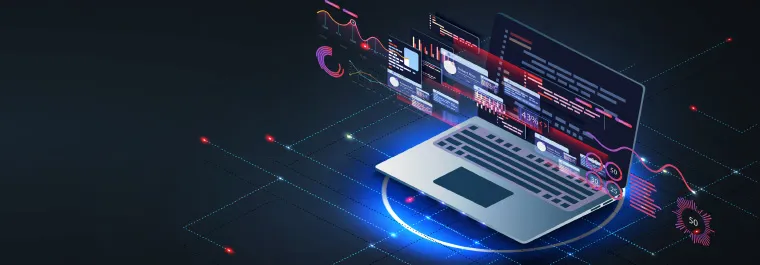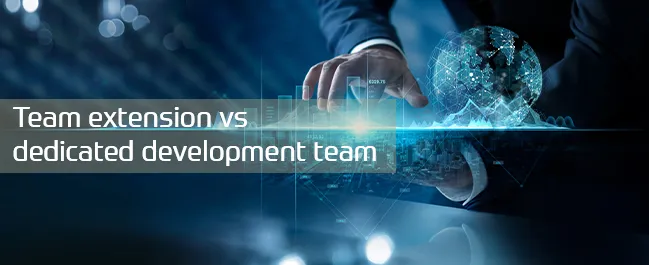
What is back-end and what it is responsible for?
What is back-end and what it is responsible for
A web application or website appears to be a graphical interface at first glance. However, there is a hidden back-end layer behind it, without which the application would not be able to function. It is a kind of car engine, while the visual layer - front-end - is its body. Below we will focus on the back-end and on the tasks of the programmers responsible for its creation.
What is back-end?
Back-end is that which we cannot see when using a web application, contrary to the front-end, which is the external layer. Back-end applies to all operations that take place on the server side. It creates the structure and general functionality of the application, its operations, databases and API (Application Programming Interface).
The back-end layer is responsible for all the output the user sees, e.g. the text that appears on the screen. In the case of interactive elements such as forms or calculators, everything what should be displayed to the user who wants to, e.g. calculate the value of his BMI or loan installments, is programmed in the back-end. The same applies to any events like clicks - reaction (e.g. loading another view) ,depending on the interaction of the front-end with the back-end.

What constitutes back-end
The back-end architecture consists of the following components:
- servers
The server is a unit that is used to perform complex operations initiated by the application source code. It is responsible, using the k compiler, for interpreting the source code and execute programmed commands, process data and return the result values accordingly. It can also store static files, which are then displayed in the target application, and perform any background operations, not strictly related to what is displayed in the application itself (e.g. calculating intermediate data). - logic
The logical layer consists of the source code that contains the business logic of the application (including objects, algorithms, services), which allows the application to perform various actions and generate results depending on the input data. It is performed by the servers, interpreting the input data and generating the output. - framework
The framework is the tool that the developer uses to build the code structure, logic, and other aspects of the back-end architecture. Tools of this type facilitate the writing and editing of code, constituting a kind of application foundation that imposes certain guidelines and patterns on the application architecture. Frameworks also contain libraries and tools that give you quick access to functions that you would otherwise have to create yourself each time. - database
A database is a collection of data on which the entire application runs. This data is stored, downloaded and properly processed by the business logic of the application, thanks to which the application relies on previously prepared sets of information. Databases are of versatile use - both in terms of simple storage of basic information, as well as more complex functions, such as caching repetitive parts of the application. - API
API is an interface that provides specific methods and actions by means of which the front-end (and not only because, for example, mobile applications as well) communicates with the backend. It enables safe and fast data exchange, thanks to which the back-end layer is separated from the front-end layer. APIs also allow you to communicate with other servers and databases to retrieve their resources (e.g. flight aggregators communicate with systems that provide information regarding flight prices).

Who is a back-end developer?
The back-end developer deals with the following aspects of the application or website operation:
- Back-end programming
The back-end code serves as the main engine of the application's operation. The back-end developer is responsible for creating this engine, i.e. the business logic that performs operations that meet the requirements of the application’s functions. The programmer must be familiar with one of the programming languages such as PHP, Java, Python, Ruby or C #. Additionally, they should know the technological background accompanying a given language, such as the framework, popular libraries or specific design patterns. It is also important to be able to use technologies with which the back-end closely cooperates (databases, caching systems, etc.) - database management
Back-end developers must know, at least at a basic level, how to operate on databases such as MySQL, PostgreSQL, Redis or others. The database is one of the key elements of the operation of more complex applications and the greater the knowledge of its operation, the better the application works (it is connected, for example, with the knowledge of writing optimal queries to the database or the use of appropriate caching mechanisms). - API support
The back-end developer needs to know which data can be safely made available to the outside world and properly create a mechanism for sharing this data (the so-called API). It is also responsible for ensuring the proper receipt and validation of externally supplied data to prevent application malfunction. - Version control
Software version control systems (such as GIT or less popular SVN) store a full history of code modifications in repositories so that they can be accessed at any time. Thanks to this, it is possible to restore or model on the older version of the code, if the need arises – the functioning of the application changes or it becomes necessary to analyze the evolution of the application code.
Version control systems also allow a larger team of programmers to work on one common code, where each programmer can apply his changes without the risk of someone else overwriting them. They allow you to develop the application in many directions, using the so-called branches, where each branch is a ramification of the main code, where you can apply new functionalities and finally connect to the main branch that contains the production code.
These are just a few of the many aspects that a back-end developer deals with. At WebMakers, our developers also use technologies such as RabbitMQ, Vagrant, Docker, Drone, Deployer, ApiPlatform, Unit Test, Elasticsearch to perform back-end activities.
Back-end with WebMakers
A properly functioning back-end is an essential element of a web application or website. The back-end is behind the layer we see, i.e. the front-end, and it would not work without it. The developers of both these aspects must work closely together.
At WebMakers, experienced specialists with many successful advanced projects work on the back-end. At the same time, they are adept at using the latest technologies and willingly undertake learning new tools. Thanks to their work, our applications work reliably, based on a solid programming basis and many years of experience.











